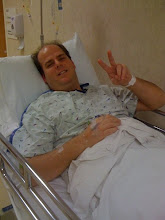Saturday, December 17, 2011
Early Blog #2
Saturday, October 3, 2009, 6:06am
Saturday morning. Two days until surgery.
It was only two days ago that I received the phone call from my neuro-ophthalmologist informing me of the findings of my MRI the night before. Up until the call, a tumor was as far away a diagnosis as I could think of. For the week before that, all signs pointed to multiple sclerosis (MS) as the likely culprit, something I was keeping secret from most everyone.
The phone call began like the old SNL sketch where a slide whistle played to indicate the actors' sense of hope: "Hi, Mr. Miller. I have studied the MRI." [Whistle up a third.] "You do not have MS." [Whistle up another third.] "You have a mass in your brain." [Whistle drops all the way down.]
The neuro-ophthalmologist told me someone would be contacting me shortly to make arrangements for MJ and me to meet with a neurosurgeon to discuss options. The meeting was in a few hours. I broke down after hanging up the phone. MJ held me and said we would get through this together, the same way we always got through things together.
We drove to St. Mary's Hospital's new Hauenstein Center, a major step up in luxury from the main building Grand Rapidians have gotten used to over the years. I noticed it had the calming ambience of a nice resort hotel—not a hospital—as we waited for the consultation. I half expected someone in a white coat to walk by with a tray bearing two coconuts with straws coming out the tops.
From the start, I liked my neurosurgeon. Of course, in this day and age I had googled him prior to the meeting, reading about his background and his rating from past patients. No red flags. He had a cool, detached, and intelligent presence. He wasn't pretending to be my best friend. I like my surgeons (and I've had a few) to be that way. Other doctors I want to have more of a connection with, but I want surgeons to think of me as a cellular structure. While he went through the motions of asking standard questions about allergies to medications, I caught him studying different spots around my eyes and nose, pondering how he might get his sharp little instruments in there.
He ordered a panel of diagnostic tests, the most important being one to rule out a prolactinoma, rarer in men because it makes you produce breast milk. Prolactinomas are treated with drugs and ESPN, not surgery. Once we knew it was not this, surgery was the only option left to get the tumor out. Even though it was probably benign, it was growing. It already made me half blind in one eye, and it would only continue to grow. One way or another, it had to come out. Since it rested just behind my sinus cavity, it could be extracted by going in my nose, tapping through a thin egg-shell-like bone, and carving it out.
Since I play the oboe for a living, it concerned me that any surgery dealing with my mouth or my sinuses (if it went wrong) could destroy my career. My neurosurgeon offered up the one alternative method—more rarely used—where you saw off the front of the forehead, push the brain to the side and reach down between the eyeballs to pop the sucker out. As he described this, MJ became intensely interested in her newspaper. I thought about it for a moment and told him we would prefer the first method.
At the end of our meeting, I asked if we could see the MRI.
"Sure," he said. "Follow me."
We went in the next room where large computer monitors flickered with black and white images of human anatomy. The screen he went to displayed a close-up of obviously someone else's neck. Most notably, I could see a metal plate and two screws holding this person's vertebrae together. It looked gothic, out of a horror movie, though certainly that patient is grateful for the things modern medicine can do for people. He closed the image and searched for my file.
"Here it is," he said, and stepped back.
The MRI showed my tumor, larger than I ever thought would be. It sat there, bulging and taking up all the free space behind my nose and eyes. About the size of a golf ball, I thought. As I looked more closely, I could imagine little blood vessels spelling, "Titleist." So there it was: at once part of me but also my foe, the enemy within.
"How long has this been there?" I asked, incredulous that something like that could be inside my head, unnoticed.
"There's no way to know," he said.
Subscribe to:
Post Comments (Atom)





No comments:
Post a Comment